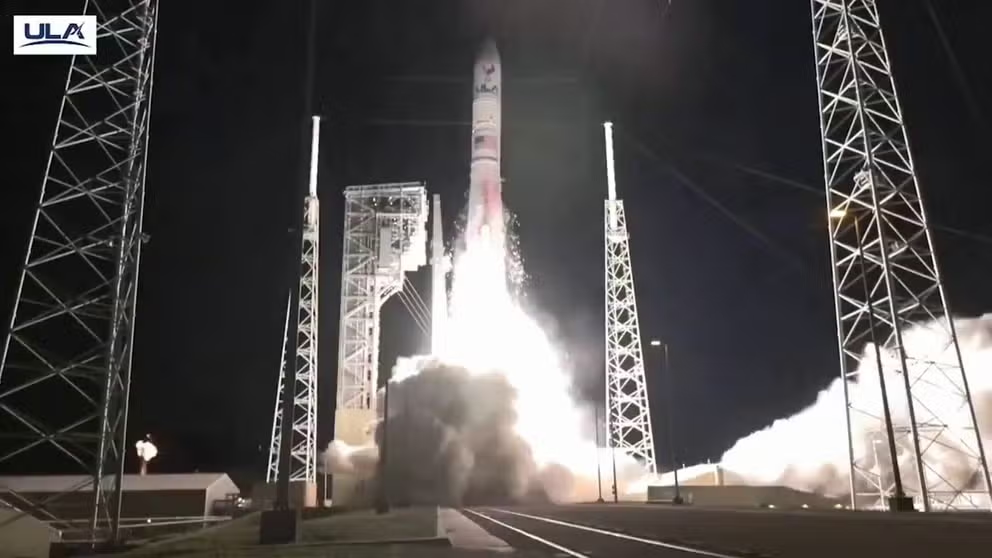Final Delta IV Heavy rocket launch scrubbed due to issue with gaseous nitrogen pipeline
The final Delta IV Heavy rocket launch was srubbed Friday due to an issue with the gaseous nitrogen pipeline, which provides pneumatic pressure to the launch vehicle systems.
Inaugural launch of ULA's Vulcan rocket
ULA's Vulcan rocket launches for the first time carrying the Peregrine Moon lander to space. The liftoff happened from Cape Canaveral, Florida on Jan. 8. (video: ULA)
CAPE CANAVERAL SPACE FORCE STATION, Fla. – United Launch Alliance is preparing the final Delta IV Heavy rocket for its swan song, sending a national security payload into orbit before concluding a 60-year history of the Delta rocket family. But the retirement will have to wait.
ULA attempted to launch the Delta IV Heavy rocket from Launch Complex 37 at Cape Canaveral Space Force Station in Florida on Thursday afternoon.
However, the launch was scrubbed after several delays and unfavorable weather early into the countdown. The company was planning to try again to launch the NROL-70 payload into orbit on Friday when the weather improved. However, the mission was scrubbed again due to an issue with the gaseous nitrogen pipeline, which provides pneumatic pressure to the launch vehicle systems.
"The team continues to troubleshoot the pipeline and more time is needed to instill confidence in the system," the company said. "We will continue to work with our customer to confirm our next launch attempt and a new launch date will be provided upon resolution."
The Delta legacy
Bruno said he’s sad to see the Delta retire, adding it has a "storied legacy" of doing "great things for our nation."
The history of the Delta rocket program dates back to the late 1950s when NASA started it.
At 233 feet tall, the Delta IV Heavy would tower above the first Delta rocket at just 90 feet tall. Ultimately, the first Delta launch in 1960 was not a success. However, the Delta rocket quickly began establishing a history of successful missions. Versions of Delta rockets launched eight missions to Mars for NASA, including Spirit and Opportunity rovers.
The Delta IV Heavy Launch vehicle started launching in 2002. All but four of its 16 missions were for the NRO. The penultimate liftoff of the rocket happened in June, launching the NROL-68 mission.
SPACECRAFT'S BLURRY VISION RESTORED AFTER SUCCESSFUL DEEP SPACE DE-ICING
Delta IV Heavy is a powerful bird to see launch.
The rocket uses half a million gallons of fuel and has three side-by-side booster cores, each with Aerojet Rocketdyne RS-68A engines that provide a combined 2.1 million pounds of thrust at liftoff.
Ahead of the Delta finale, Bruno explained to reporters why the rocket "lights itself on fire before it goes to space."

ULA's Delta IV Heavy rocket launches from Cape Canaveral, Florida, sending NASA's Parker Solar Probe into space on Aug. 12, 2018. (Image: NASA/ULA)
To prepare the rocket's RS-68A engines, very cold cryogenic hydrogen propellant is sent flowing into the engines before they ignite.
"Hydrogen is lighter than air, so after it flows through the engine and the flame trench, it then rises," Bruno said.
After the main fuel load is dropped and the engines ignite, the flame travels where the hydrogen clings to the booster's side.
Bruno said one of his favorite memories of a Delta launch was the launch of NASA's Parker Solar Probe in 2018. The Sun-observing mission was named after solar physicist Eugene Parker, Ph.D., who was also there to witness the launch. Parker died in 2022 at 94 years old.
ULA is replacing its workhorse rocket, the Atlas V, and the Delta Heavy with the new Vulcan rocket. The Atlas series uses Russian-made RD-180 engines. Vulcan uses American-made hardware, including Blue Origin and Aerojet Rocketdyne engines.
The company’s inaugural Vulcan launch happened in January, launching Astrobotic’s robotic mission to the Moon. While Astrobotic’s mission did not ultimately reach the Moon, the lunar orbital assist from ULA went flawlessly, according to both companies.
